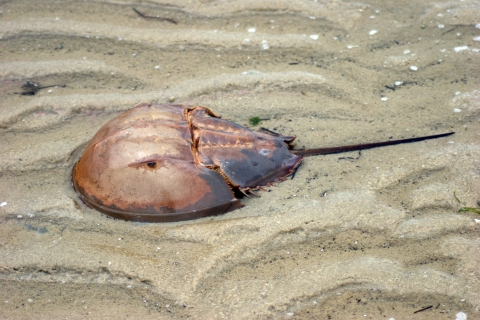Some beachgoers prefer the feel of soft, fine sand underfoot. But not horseshoe crabs.
For these ancient arthropods, fine sand can be a death trap.
Much like sea turtles, horseshoe crabs lumber onto shore to lay their eggs, which typically incubate in the sand for two to four weeks before hatching.
“If the sand is too fine, the eggs won’t get enough air, and they’ll suffocate,” explained Joseph Smith, wildlife biologist at Edwin B. Forsythe National Wildlife Refuge in New Jersey.
That’s not just bad for horseshoe crabs — it’s bad for the many bird species that rely on horseshoe crab eggs for fuel during spring migration, including red knots, ruddy turnstones, semipalmated sandpipers and dunlins.
All along the Atlantic Coast, coastal birds are stressed by habitat loss and human disturbances in vital stopover and nesting areas. These birds need more beaches that suit horseshoe crabs.
The sands of time
Historically, the beaches where Atlantic horseshoe crabs spawn along Delaware Bay — home to the largest population in the world — would have been just right, with coarse, deep sand and minimal wave action, thanks to the contours of the surrounding landscape.
But for centuries, people have altered the coastline in ways that stunt the natural growth of beaches, like building seawalls that prevent offshore currents from transporting and redepositing sand.
Although in recent decades, managers have started adding sand to eroding beaches — a practice known as beach nourishment — to counteract historical changes that hurt coastal systems, for a long time, people figured sand was sand.
Recent research, including a study co-authored by Smith, has reinforced the benefits of beach nourishment for horseshoe crabs, shorebirds and people but also shows that right-sizing sand is key to achieving conservation outcomes.
"Coarse" correction
Until recently, Turtle Cove at Forsythe National Wildlife Refuge was a wildlife beach in need of nourishment.
The beach was built in the 1960s to protect the dike that supports the refuge’s Wildlife Drive, but it provided habitat for horseshoe crabs and shorebirds, too. Then in 2012, Hurricane Sandy hit — washing away the sand and leaving the road vulnerable. As a short-term fix, the refuge installed rocks to stabilize the shoreline, reducing the amount of spawning habitat as a result.
Then an opportunity came along for a course — and coarse — correction.
In 2023, our Science Applications program directed $20,000 to teams addressing the conservation needs of groups of species considered at risk for steep population declines, including Atlantic Coast shorebirds.
For the shorebird team, which has focused on restoring and managing habitat, reducing human disturbance and managing predators, using the funds to nourish the beach at Turtle Cove was a perfect fit.
To lay the groundwork, our Coastal Program provided funding to Stockton University Coastal Research Center to develop a design for the beach expansion. Using historical information and high-precision GPS data, researchers modeled how sand was likely to move within the system over time to determine the best placement location.
Before getting started, refuge biologists collected data on horseshoe crab and shorebird abundance on the existing beach to provide a baseline for comparison once the project is complete.
The funding from Science Applications paid for the raw materials: 1,850 tons of coarse sand from a quarry in New Jersey.
After the sand was delivered, Roger Dutch and Shawn Daly from the refuge’s maintenance staff spent two weeks putting it in place with heavy equipment — strategically heaping it near the middle of the site so the wind and waves could redistribute it where it belongs within the system.
Shoring up shorebirds
While the project is still a work in progress — more sand is needed to finish rebuilding the beach — it is already providing a small-but-strategic boost to a group of birds that needs help.
But there are benefits beyond birds. A wider beach made of coarser sand that won’t get swept away is a nature-based solution to the problem of increasingly frequent intense storms that threaten the Wildlife Drive.
And on picture-perfect spring days, the expanded beach will give visitors more opportunities to stop on the side of the road to appreciate shorebirds that are also stopping for a break — and likely still have long journeys ahead of them.








